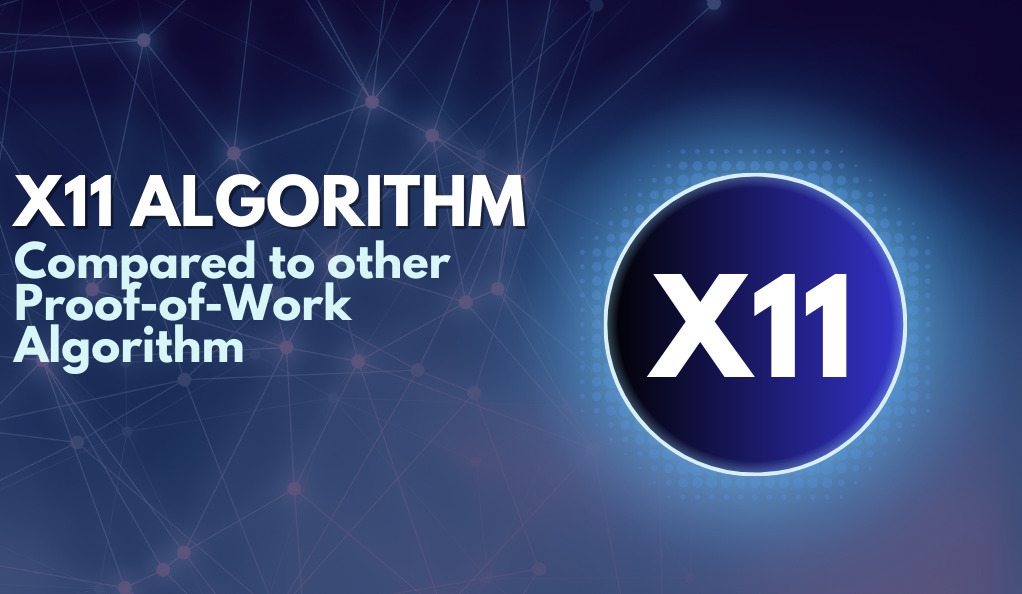In the dynamic and intricate world of cryptocurrencies, the foundation of any digital currency lies in the algorithms that drive them. These algorithms, often complex and meticulously crafted, are the heartbeat of the cryptocurrency, ensuring its security, dictating its efficiency, and shaping its potential for widespread adoption. As various algorithms have emerged over the years, each bringing its unique features and benefits, the X11 algorithm has managed to stand out, capturing the attention and intrigue of the crypto community.
Introduced as a revolutionary approach to cryptographic hashing, X11 brought with it a promise of enhanced security and fairness in mining. Unlike many of its contemporaries that rely on a singular hashing function, X11 is distinguished by its chained hashing technique, employing a sequence of eleven distinct scientific hashing algorithms. This multi-layered approach not only fortified its defense against potential threats but also positioned it as a forward-thinking solution in a space that is constantly evolving. The buzz around X11 isn’t just about its technical prowess; it’s also a reflection of the crypto community’s desire for innovation, decentralization, and a more equitable digital currency landscape.
What is X11?
X11 is a unique chained hashing algorithm that utilizes a sequence of eleven distinct scientific hashing algorithms for its proof-of-work mechanism. This intricate design ensures that the processing distribution remains fair, aiming to emulate the initial distribution approach of Bitcoin. The name “X11” isn’t derived from any complex cryptographic terminology but simply denotes the use of 11 different hash functions.

The Brain Behind X11: Evan Duffield
The X11 algorithm was the brainchild of Evan Duffield, who introduced it in 2014. Duffield is also the main developer behind the Darkcoin cryptocurrency, which was later rebranded as Dash. His primary motivation behind creating X11 was to establish an algorithm that would safeguard cryptocurrencies from the dominance of specialized mining devices known as ASICs (Application-Specific Integrated Circuits). These ASICs, due to their sheer power and efficiency, have often been labeled as potential threats to the decentralized nature of cryptocurrencies.
Duffield’s vision was clear: to create an algorithm that would act as a bulwark against the potential centralization of cryptocurrency mining. He believed that the complexity of X11 would deter the development and use of ASIC miners, at least for a considerable period, allowing the cryptocurrency ecosystem to flourish without the looming shadow of mining centralization.
X11 Algorithm at a Glance
| Feature | Description |
|---|---|
| Introduced By | Evan Duffield |
| Year of Introduction | 2014 |
| Primary Use | Proof-of-work for cryptocurrencies |
| Number of Hash Functions | 11 |
| Notable Cryptocurrency | Dash (formerly Darkcoin) |
| ASIC Resistance | Initially resistant, but ASICs for X11 were eventually developed |
The Genesis of X11
The story of X11 is deeply intertwined with the evolution of the Dash cryptocurrency. Dash, initially known as Darkcoin, was the first cryptocurrency to adopt the X11 algorithm. But what drove its creation, and how did it aim to revolutionize the crypto landscape?
Evan Duffield’s journey with X11 began with a skepticism towards the reliability of the widely-used SHA-256 algorithm. While SHA-256 had been the backbone of Bitcoin, Duffield believed that its simplicity could lead to potential vulnerabilities, especially with the rise of powerful mining pools. These pools, if unchecked, could amass significant control over the cryptocurrency, leading to centralization and potential manipulation.
Decentralization at Heart
Duffield’s primary goal with X11 was to prevent such centralization issues. He envisioned a cryptocurrency landscape where power wasn’t concentrated in the hands of a few, but was instead distributed widely, ensuring fairness and security. The X11 algorithm, with its complexity and resistance to ASICs, was seen as a step in that direction.
Beyond decentralization, Duffield was also concerned about the overall security of the mining process. With the increasing reports of hacks and breaches in the crypto world, Duffield wanted an algorithm that offered enhanced protection. The sequential hashing mechanism of X11, which consists of multiple rounds, was designed to bolster security against potential attacks. Duffield emphasized that the SHA-256 algorithm, despite its widespread use, couldn’t be deemed 100% hack-proof. In contrast, X11, with its multi-layered approach, aimed to provide a more fortified defense.
Evolution and Adaptation
Following the launch of X11, the crypto community witnessed the introduction of its variants. These new versions, while based on the original X11, featured different numbers of rounds. Among these, the X17 algorithm gained notable popularity. However, it’s essential to understand that these adaptations were more evolutionary than revolutionary, building upon the foundational principles set by X11.
The Technicalities of X11
Diving into the mechanics of X11 reveals a sophisticated design that sets it apart from many other cryptographic algorithms. Its complexity isn’t just for show; it serves a purpose, ensuring a fair distribution of processing and a formidable defense against potential threats.
Chained Hashing: A Symphony of Algorithms
At its core, X11 employs a chained hashing approach. This means that it doesn’t rely on just one, but a sequence of eleven scientific hashing algorithms. When data is fed into the X11 algorithm, it undergoes a series of transformations, each managed by a different hash function. This data is then passed from one function to the next in a predetermined sequence, ensuring a comprehensive and secure hashing process.
The Eleven Pillars of X11
The eleven hash functions that constitute X11 are: Blake, BMW, Groestl, JH, Keccak, Skein, Luffa, Cubehash, Shavite, Simd, and Echo. Each of these functions brings its own set of cryptographic strengths to the table, making the combined X11 algorithm a powerhouse of security and efficiency.
While X11’s approach might remind some of the chained-hashing technique of Quark, there are distinct differences. In Quark, the rounds of hashes are determined randomly, whereas X11’s sequence is predetermined. This adds an additional layer of depth and complexity to X11, ensuring that it remains consistent in its operations.
Beyond Just Cryptocurrencies
It’s worth noting that the name “X11” isn’t exclusively tied to the world of cryptocurrencies. In the realm of UNIX-like operating systems, X11 also refers to an open-source windowing system. However, in the context of crypto, X11 stands as a testament to intricate design and cryptographic prowess.
X11 and ASIC Miners

The relationship between X11 and ASIC miners is a tale of evolution, adaptation, and the relentless march of technology.
When Evan Duffield first introduced X11, a significant selling point was its resistance to ASIC miners. ASICs, with their specialized designs, can often outperform general-purpose hardware, leading to potential centralization in mining. X11’s complexity was seen as a deterrent for the development of ASICs, at least in its early days.
Reality Sets In: The Advent of X11 ASICs
Despite the initial intentions, the world of technology is ever-evolving. By early 2016, ASICs designed specifically for the X11 algorithm began to surface. These devices, while bringing in increased efficiency, also raised concerns about the centralization of mining power. However, it’s essential to understand that while these ASICs have become a significant part of the network’s hashrate, they haven’t led to the extreme centralization seen in some other cryptocurrencies.
Today, while ASICs for X11 are prevalent, GPU mining remains a viable option for many. The balance between ASIC and GPU mining ensures that no single group can dominate the mining landscape, preserving the decentralized ethos of cryptocurrencies.
Advantages of the X11 Algorithm

The X11 algorithm, with its unique design and approach, offers a range of advantages that have made it a preferred choice for several cryptocurrencies.
1. Enhanced Security
One of the standout features of X11 is its multi-layered security. By employing eleven different hash functions, X11 ensures that even if one or a few of these functions were to be compromised, the entire system would not be vulnerable. This redundancy provides a robust defense mechanism against potential threats.
2. Energy Efficiency
X11 is known for its energy-efficient design, especially when compared to algorithms like SHA-256. Miners using X11 have reported reduced power consumption, which not only lowers costs but also contributes to a more environmentally friendly mining process.
3. Reduced Heat Generation
Associated with its energy efficiency is X11’s ability to reduce heat generation during the mining process. This ensures longer hardware lifespans and reduces the risks of overheating, which can be a common concern in mining operations.
4. ASIC Resistance (Initially)
While ASICs for X11 eventually came into existence, the algorithm’s initial design did offer resistance against these specialized miners. This allowed for a more decentralized mining environment in the early days of X11-based cryptocurrencies.
5. Fair Distribution
The complexity of X11 ensures that the processing distribution remains fair. This means that coins mined using this algorithm are distributed in a manner similar to the early days of Bitcoin, preventing the concentration of mining power.
Disadvantages and Criticisms
No algorithm is without its challenges or criticisms, and X11 is no exception.
1. Evolution of ASICs
One of the primary criticisms of X11 is its eventual susceptibility to ASIC miners. While it was initially resistant, the development of X11-specific ASICs has raised concerns about mining centralization.
2. Increased Complexity
The very feature that provides X11 with its security and advantages – its complexity – is also a point of criticism. The use of eleven hash functions means that the algorithm is more complex to implement and understand, especially for newcomers.
3. Emergence of Advanced Variants
Post the introduction of X11, several variants like X12, X13, and X17 were introduced. These newer algorithms, built on more hash functions, have been perceived by some as superior to X11, making the latter seem outdated to a certain extent.
4. Not Entirely Future-Proof
While X11 was designed to be forward-thinking, the rapid pace of technological advancements in the crypto world means that no algorithm can truly be future-proof. The development of X11 ASICs is a testament to this fact.
In the grand tapestry of cryptographic algorithms, X11 has carved its niche, offering a blend of security, efficiency, and innovation. As with all technologies, it has its strengths and weaknesses, but its impact on the world of cryptocurrencies is undeniable. As we move forward, it will be interesting to see how X11 adapts and evolves in response to the ever-changing crypto landscape.
X11 in the Cryptocurrency Landscape
The influence of the X11 algorithm extends beyond its technical merits. Its adoption by various cryptocurrencies and its role in shaping the mining ecosystem offers insights into its broader significance.
Cryptocurrencies Embracing X11
Dash is undoubtedly the most renowned cryptocurrency to utilize the X11 algorithm. However, it’s not alone. Several other digital currencies have recognized the benefits of X11 and incorporated it into their frameworks. Some notable coins include:
- Dash: Originally known as Darkcoin, Dash is the poster child for X11, showcasing its features on a global stage.
- Pura: A digital currency aiming for mass adoption with a focus on swift transactions.
- CannabisCoin: Tailored for the cannabis industry, this coin leverages X11 for secure and efficient transactions.
- StartCoin: A digital currency that emphasizes crowdfunding and project support.
- Sibcoin: A coin that originated from Dash but caters specifically to the Russian community.
This diverse adoption underscores X11’s versatility and its appeal to various sectors within the cryptocurrency world.
Mining Dynamics with X11
The mining landscape for X11 presents a blend of opportunities and challenges. On the one hand, the algorithm’s energy efficiency and reduced heat generation make it attractive for individual miners and smaller mining operations. On the other, the emergence of X11 ASICs has shifted some of the mining power dynamics, favoring those who can invest in specialized equipment.
However, the balance between ASIC and GPU mining for X11 has ensured a level of decentralization, preventing any single entity or group from gaining undue influence over the network.
The Future Outlook
As the cryptocurrency domain continues to evolve, so will the algorithms that underpin it. X11, with its rich history and proven track record, is poised to remain a significant player. However, it will face competition from newer algorithms that promise greater efficiencies, security, or both.
The true testament to X11’s resilience will be its ability to adapt to these challenges, whether through updates, forks, or integration with other technologies. Only time will tell how X11 will navigate these waters, but its legacy in the crypto world is firmly established.
Conclusion
The X11 algorithm stands as a beacon of innovation in the dynamic world of cryptocurrencies. Born from a desire to address the limitations of existing algorithms, its unique chained hashing approach and commitment to security, fairness, and decentralization have set it apart. While Dash remains its most prominent ambassador, X11’s influence extends far beyond, with its adoption by various coins underscoring its versatility and universal appeal.
As the cryptocurrency landscape continues to evolve, X11’s legacy serves as a testament to the spirit of innovation and the relentless pursuit of excellence. Its journey, marked by adaptability and resilience, offers valuable insights for the future, reminding us of the endless possibilities and the enduring value of a well-crafted algorithm in the digital currency realm.
At axerunners.com, our goal is to furnish well-rounded and trustworthy information regarding cryptocurrency, finance, trading, and stocks. Nonetheless, we avoid providing financial advice and instead encourage users to conduct their own research and meticulous verification.
Read More













